Insulated copper tapes for shielding or as current conductors in transformers and coils, especially also for solar energy and hybrid drive technology (voltage transformers).
Advantages of flat copper cables (copper shielding films)
-
Significantly reduced skin effect below 100 kHz, high current carrying capacity
-
Flat copper conductors can be wound very tightly at high tensile forces. This effectively prevents vibration of the coil former (e.g. 50Hz hum) and dissipates the resulting heat loss.
-
Low inductive reactance from 5 Hz to 50 kHz Due to good conductivity and low skin effect, very good (loss) heat to power ratio. Significantly higher power density compared to wire wound coils.
-
Very fast production of a shield between input and output winding, since only one winding is necessary (DIN EN 61558; IEC 60950 Safety of Information Technology Equipment)
-
Lower capacitive content than round wire windings and excellent quality (audio applications)
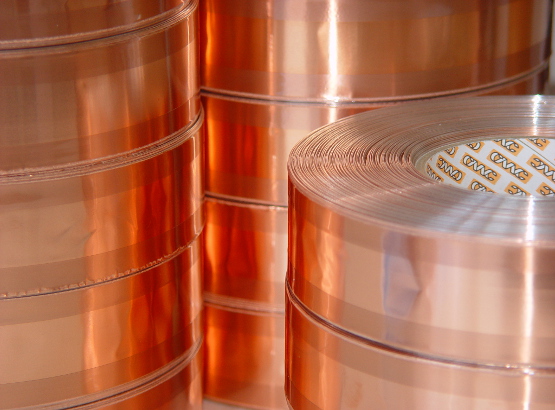
-
As an interlayer shield, prevention of winding shorts between primary and secondary windings
-
For the production of induction loops (ring loops, ring loop systems) for hearing aid systems.
-
Insulated copper flat wire can also be used for busbars
more information
- Thickness range copper film: 35 - 300 µm (other thicknesses on request)
- Conductor cross-sections from approx. 0.1 mm² to approx. 45 mm² possible
- Electrolytic copper E-Cu 58 is used, soft with a specific resistance of 0.017 Ohm x mm² /m. Roughly, one can calculate with 2-2.5 A per mm² area current carrying capacity (with moderate self-heating).
- On request also with 10µm copper film - super flat design!
- On request, we can also supply bare copper film, cut to the required width.
- Alternatively aluminum on request
- Delivery form: roll, 5 - 300 mm width (depending on copper thickness and design)
- Application: EMC protection, insulation according to DIN VDE 551, EN60742, as current winding in power transformers
-
also possible with double and triple insulation
-
for class F also available with PEN film
-
for even better heat dissipation with Kapton® MT insulation
-
also with two conductors in parallel for more complex winding designs
-
also available with three-layer insulation (three separable layers; if required, with adhesive insulating tape that has passed the mandrel test from EN 61558)
-
other constructions desired? Inquire!
|
1-fold insulation |
Polyester |
Nomex |
Kapton |
PEN |

|
CMC 38181* |
CMC 38281* |
CMC 38381* |
CMC 38481 |

|
CMC 38191* |
CMC 38291* |
CMC 38391* |
CMC 38491 |

|
CMC 38182* |
CMC 38282* |
CMC 38382* |
CMC 38482 |

|
CMC 38190* |
CMC 38290* |
CMC 38390* |
CMC 38490 |

|
CMC 38192* |
CMC 38292 |
CMC 38392 |
CMC 38492 |
| 2-fold insulation | Polyester | Nomex | Kapton | PEN |
 | CMC 38193* | - | CMC 38393* | CMC 38493 |
 | CMC 38194* | - | CMC 38394* | CMC 38494 |
Other design options of copper shielding strip
Parallel routed, individually insulated power lines on a double-sided adhesive carrier. For example, for simultaneous laying of DC supply lines in furniture with LED lighting. Very easy installation due to self-adhesive equipment of the supply lines, extremely low overall height.
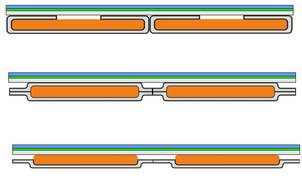
Insulated copper tapes series CMC 38xxx as shield winding
In addition to the desired inductive coupling, (undesired) capacitive transmission of higher-frequency interference signals can also occur in transformers and coils.
To avoid this, a shield made of copper film can be inserted between the windings of a transformer. This shield winding acts like a Faraday cage for the electric field, but hardly affects the magnetic energy transmission. Capacitive coupling can be drastically reduced in this way. The use of insulated copper films as a shield winding on ring transformers (EMC shield) is particularly well known.
The shield winding is usually only connected on one side and is connected to ground.
Another use for insulated copper films are shield windings, which are used as additional insulation protection. In the event of an insulation fault, there is no breakdown from the primary to the secondary side of the transformer. Rather, the insulation fault is intercepted by the shield winding in between. A fuse element connected to the shielding can then trip a fuse, for example, in the event of an insulation fault.
Laminates of copper films (aluminum films) and insulating films are also used as current conductors in transformers (insulated flat copper conductors). The main advantage here is the high surface area of the profiled copper in relation to the cross-sectional area. At high currents and high frequencies, the conductor surface is primarily responsible for electrical conduction due to charge carrier displacement (skin effect). In addition, copper strips with high tensile forces can be wound tightly onto the winding support. This avoids vibrations and increases the power density. In addition, heat dissipation is improved by the intimate contact, which can be further supported by thermally conductive insulation.
Advantages of insulated copper films:
-
Prevent capacitive coupling
-
Increase safety as a shield between primary and secondary winding
-
Have a large surface area (replacement for stranded wire)
-
Can be used up to class H (Polyester, PEN, Kapton®)
-
High current carrying capacity, high current carrying capacity (e.g. TIG welding)
-
Compliance with clearances and creepage distances due to insulation
-
Easy wire connection by soldering thanks to soldering gap
-
Insulated on one and both sides, also multilayer insulation
-
Available in very many widths and material thicknesses
Correct handling of copper shielding tape CMC 38xxx in production
One of the most important aspects when handling the reels is the protection of the sensitive edges. With versions such as CMC 38190, the rather thin but stress-resistant insulation can easily be damaged by placement errors. As a result, only insufficient dielectric strength is achieved.
Here you will find written processing instructions, which you can also hand out to your employees.
For power transformers: Up to 1000µm copper film
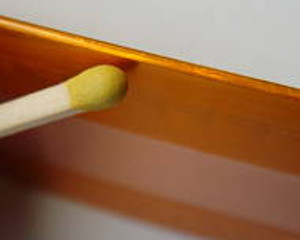
Flat copper conductors up to 1,500µm Particularly in solar technology (converters for solar power) and for charging electric vehicles, very large currents are converted into high voltages or vice versa. The solid copper conductors required for the current side are nowadays mainly manufactured with wires in the form of insulated flat copper strips. When using such insulated strips, it should be noted that the dielectric strength changes significantly as a function of temperature and, above all, frequency. In particular, pulsed edges with a few nanoseconds rise time stress the insulation material. Partial discharges must be avoided.
CMC Klebetechnik offers - customized - insulated copper tapes made of electrolytic soft copper up to 1000µm copper thickness. Inquire!
The above information as well as our technical application advice, whether verbal, in writing or by means of tests, are given to the best of our knowledge, but are to be regarded only as non-binding advice. The advice does not release you from your own examination of our current advisory notes, in particular our data sheets and technical information, as well as our products with regard to their suitability for the intended processes and purposes.
Multiple lines on the running meter
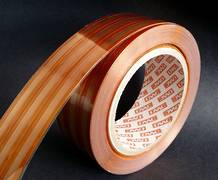
For some constructions or power supplies it is advantageous to have several insulated flat copper conductors next to each other on a carrier film. The carrier film "bundles" the individual conductors into one cable.
For DC power supplies - e.g. of LED lighting - a combination of a copper conductor and a tinned copper conductor is available. Reverse polarity is thus a thing of the past (see picture).
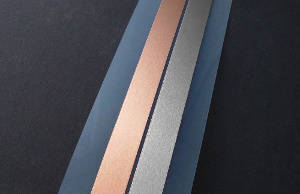
DC power supply line with "reverse polarity protection
You can get up to three insulated flat copper lines side by side. Please inquire if you have a specific need!
Current carrying capacity of single conductors
Ambient temperature 30°C (self-heating approx. 30°C)
| Wire cross section | 0,75mm² | 1,00mm² | 1,5mm² |
| Current carrying capacity duration max. | 6A | 10A | 13A |
Ambient temperature 40°C (self-heating approx. 30°C)
| Wire cross section | 0,75mm² | 1,00mm² | 1,5mm² |
| Current carrying capacity duration max. | 4,9A | 8,2A | 10,7A |
Ambient temperature 50°C (self-heating approx. 30°C)
| Wire cross section | 0,75mm² | 1,00mm² | 1,5mm² |
| Current carrying capacity duration max. | 3,5A | 5,8A | 7,5A |